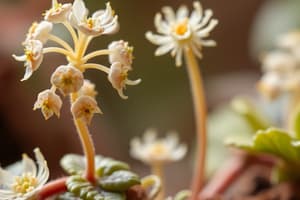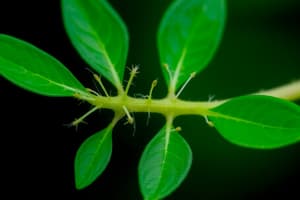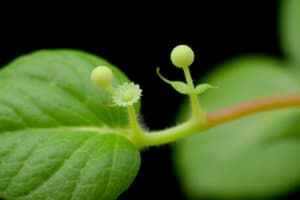Podcast
Questions and Answers
What type of cambium is formed between the xylem and phloem in dicot stems?
What type of cambium is formed between the xylem and phloem in dicot stems?
- Vascular cambial ring
- Interfascicular cambium
- Intrafascicular cambium (correct)
- Medullary cambium
Which type of initial is more abundant in the vascular cambium?
Which type of initial is more abundant in the vascular cambium?
- Medullary initials
- Fusiform initials (correct)
- Interfascicular initials
- Ray initials
What is the primary outcome of the periclinal divisions in fusiform initials?
What is the primary outcome of the periclinal divisions in fusiform initials?
- Formation of primary phloem
- Formation of cambial cells only
- Formation of primary xylem
- Formation of secondary phloem and xylem (correct)
What happens to primary phloem during secondary growth?
What happens to primary phloem during secondary growth?
How many times more secondary xylem is formed compared to secondary phloem?
How many times more secondary xylem is formed compared to secondary phloem?
Which cells are responsible for forming the cambial ring?
Which cells are responsible for forming the cambial ring?
What type of cambium develops from the cells of medullary rays?
What type of cambium develops from the cells of medullary rays?
What is the shape of fusiform initials in the vascular cambium?
What is the shape of fusiform initials in the vascular cambium?
What type of meristem is responsible for primary growth in plants?
What type of meristem is responsible for primary growth in plants?
Secondary growth in plants primarily occurs due to which type of meristem?
Secondary growth in plants primarily occurs due to which type of meristem?
Which type of vascular tissue is produced by the vascular cambium?
Which type of vascular tissue is produced by the vascular cambium?
Which characteristic is true about secondary growth in plants?
Which characteristic is true about secondary growth in plants?
What is the role of the cambium in secondary growth?
What is the role of the cambium in secondary growth?
How do dicots differ from monocots regarding growth?
How do dicots differ from monocots regarding growth?
Which component of vascular tissue primarily transports water and dissolved minerals?
Which component of vascular tissue primarily transports water and dissolved minerals?
What happens to the primary xylem and phloem during secondary growth?
What happens to the primary xylem and phloem during secondary growth?
What is the primary difference in the arrangement of xylem and phloem between monocots and dicots?
What is the primary difference in the arrangement of xylem and phloem between monocots and dicots?
Which type of cambium is responsible for the formation of secondary vascular tissues?
Which type of cambium is responsible for the formation of secondary vascular tissues?
What is the primary growth in plants caused by?
What is the primary growth in plants caused by?
Which statement accurately describes cambium activity in monocots?
Which statement accurately describes cambium activity in monocots?
What does the activity of cambium primarily lead to in plant stems?
What does the activity of cambium primarily lead to in plant stems?
How does secondary growth occur in some monocots like Palm and Coconut?
How does secondary growth occur in some monocots like Palm and Coconut?
What are the roles of the two types of cambium in woody plant stems?
What are the roles of the two types of cambium in woody plant stems?
What happens to the cambium cells each time they divide?
What happens to the cambium cells each time they divide?
What happens to the primary tissues in the center of the stem during secondary growth?
What happens to the primary tissues in the center of the stem during secondary growth?
What characterizes heartwood compared to sapwood?
What characterizes heartwood compared to sapwood?
What is the main function of sapwood?
What is the main function of sapwood?
What occurs to the cavities in heartwood that prevents water conduction?
What occurs to the cavities in heartwood that prevents water conduction?
Tyloses play what role in the heartwood of a plant?
Tyloses play what role in the heartwood of a plant?
Why is the destruction of sapwood detrimental to a plant?
Why is the destruction of sapwood detrimental to a plant?
Which of the following statements about heartwood is false?
Which of the following statements about heartwood is false?
What is the primary characteristic of the waste materials found in heartwood?
What is the primary characteristic of the waste materials found in heartwood?
Flashcards
Apical Meristem
Apical Meristem
A type of plant tissue that is responsible for primary growth, allowing the plant to grow in length.
Lateral Meristem
Lateral Meristem
A type of plant tissue that is responsible for secondary growth, allowing the plant to grow in width.
Primary Growth
Primary Growth
Growth that occurs at the apical meristem, increasing the length of the plant.
Secondary Growth
Secondary Growth
Signup and view all the flashcards
Vascular Cambium
Vascular Cambium
Signup and view all the flashcards
Cork Cambium
Cork Cambium
Signup and view all the flashcards
Xylem
Xylem
Signup and view all the flashcards
Phloem
Phloem
Signup and view all the flashcards
Monocot vascular bundles
Monocot vascular bundles
Signup and view all the flashcards
Dicot vascular bundles
Dicot vascular bundles
Signup and view all the flashcards
Cambium
Cambium
Signup and view all the flashcards
Monocot secondary growth
Monocot secondary growth
Signup and view all the flashcards
Intrafascicular Cambium
Intrafascicular Cambium
Signup and view all the flashcards
Interfascicular Cambium
Interfascicular Cambium
Signup and view all the flashcards
Vascular Cambial Ring
Vascular Cambial Ring
Signup and view all the flashcards
Fusiform Initials
Fusiform Initials
Signup and view all the flashcards
Ray Initials
Ray Initials
Signup and view all the flashcards
Periclinal Division
Periclinal Division
Signup and view all the flashcards
Secondary Xylem vs. Secondary Phloem
Secondary Xylem vs. Secondary Phloem
Signup and view all the flashcards
Heartwood
Heartwood
Signup and view all the flashcards
Sapwood
Sapwood
Signup and view all the flashcards
Tyloses
Tyloses
Signup and view all the flashcards
What is the function of heartwood?
What is the function of heartwood?
Signup and view all the flashcards
What happens when heartwood is destroyed?
What happens when heartwood is destroyed?
Signup and view all the flashcards
What happens when sapwood is destroyed?
What happens when sapwood is destroyed?
Signup and view all the flashcards
Why does heartwood become darker?
Why does heartwood become darker?
Signup and view all the flashcards
Xylotomy
Xylotomy
Signup and view all the flashcards
Study Notes
Plant Stem Growth
- Plant stem growth occurs at meristems in the shoot system
- Two types of meristems: apical and lateral
- Apical meristems cause lengthwise growth
- Lateral meristems cause outward (thicker) growth
- Secondary growth is the increase in girth of stems/branches in some plants
- Secondary growth is caused by lateral meristems called cambium
- Two important types of cambium: vascular cambium and cork cambium
- Vascular cambium creates more vascular tissue (xylem and phloem)
- Xylem transports water and minerals
- Phloem transports food
- Secondary xylem and phloem increase plant width
- Secondary growth occurs only in dicots, not monocots
- Monocot stems have vascular bundles scattered throughout
- Dicot stems have vascular bundles in rings (xylem inside, phloem outside)
- Cambium is meristematic tissue for lateral growth; two types in woody stems, increasing diameter
- Vascular cambium produces secondary vascular tissue (xylem and phloem)
- Cork cambium forms the bark
Cambium Structure
- Cambium is a single layer of cells
- Cells divide parallel to epidermis
- Cells differentiate into permanent tissue (xylem or phloem based on location)
- Secondary growth in stems and roots of dicots and gymnosperms
- Secondary growth in part of monocots but not common
- Secondary growth in stems begins earlier in the stelar region
- Early secondary growth forms a ring
Formation of Cambium Ring
- Vascular bundles are xylem and phloem bundles in stems
- Intrafascicular cambium is within vascular bundles (primary meristem)
- Secondary growth causes interfascicular cambium to form as cells in medullary rays differentiate
- Complete ring is formed from intrafascicular and interfascicular cambia (vascular cambium ring)
- Two types of cells in vascular cambium ring: Fusiform and ray initials
Secondary Growth Details/Processes
- Fusiform initials are long and pointed, while ray initials are spherical
- Periclinal or tangential divisions occur in fusiform initials, parallel to longitudinal axis
- Cells produced by division differentiate into secondary xylem (towards center) or secondary phloem (towards outside)
- Secondary xylem and phloem formation pushes existing tissues (primary phloem, pith) outward or inward, respectively
- Secondary xylem forms in greater amount than phloem in most plants
- Secondary xylem formation blocks water transport
- Sapwood (outer part of wood) carries water and nutrients, and is lighter in color
- Heartwood (inner part) contains waste products, making the wood dark
Studying That Suits You
Use AI to generate personalized quizzes and flashcards to suit your learning preferences.




